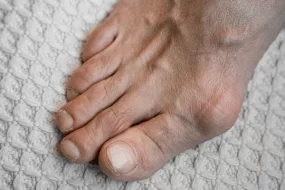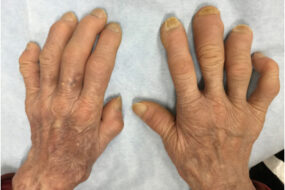- Home
- INTERNAL MEDICINE
- Primary Biliary Cholangitis

Primary Biliary Cholangitis (PBC) is a chronic autoimmune liver disease characterized by progressive destruction of the small intrahepatic bile ducts. This results in cholestasis, fibrosis, and potentially, cirrhosis and liver failure. PBC predominantly affects middle-aged women and has a higher prevalence in those with other autoimmune diseases.
Pathophysiology
The exact cause of PBC remains unclear, but it is thought to involve a combination of genetic, environmental, and immunological factors. Key mechanisms include:
- Autoimmune Mechanism:
- The immune system mistakenly targets the small bile ducts, leading to inflammation and destruction of the epithelial cells lining the ducts.
- Antimitochondrial antibodies (AMA), present in about 90-95% of PBC patients, target the pyruvate dehydrogenase complex (PDC-E2) on the mitochondrial membrane of biliary epithelial cells.
- Genetic Predisposition:
- Genetic factors increase susceptibility to PBC, as indicated by familial clustering and associations with certain human leukocyte antigen (HLA) alleles (e.g., HLA-DRB1).
- Environmental Factors:
- Infections (e.g., urinary tract infections), chemicals, and smoking may trigger the autoimmune response in genetically susceptible individuals.
Epidemiology
- Prevalence: PBC is more common in women, with a female-to-male ratio of about 9:1.
- Age: Most commonly diagnosed in individuals aged 40-60 years.
- Geography: Higher prevalence in North America and Northern Europe.
Clinical Features
The presentation of PBC can range from asymptomatic to symptomatic, with symptoms typically developing over years.
- Asymptomatic Stage:
- Approximately 25-50% of patients are asymptomatic at diagnosis, often identified through elevated liver enzymes during routine testing.
- Even in asymptomatic patients, liver biopsy may reveal significant histological changes.
- Symptomatic Stage:
- Fatigue: One of the most common symptoms, often debilitating and disproportionate to the degree of liver damage.
- Pruritus (Itching): Often precedes jaundice and can be severe. The mechanism is thought to involve accumulation of bile acids, endogenous opioids, and pruritogens.
- Jaundice: Late manifestation due to elevated serum bilirubin levels.
- Right Upper Quadrant Pain: Due to liver capsule stretching.
- Complications Associated with Advanced Disease:
- Cirrhosis and Portal Hypertension: Leading to ascites, variceal bleeding, and hepatic encephalopathy.
- Osteoporosis and Osteomalacia: Due to malabsorption of fat-soluble vitamins.
- Hyperlipidemia: Elevated cholesterol levels are common but do not appear to increase the risk of cardiovascular disease in PBC patients.
- Fat-Soluble Vitamin Deficiencies (A, D, E, K): Due to impaired bile flow and fat absorption.
Diagnostic Approach
The diagnosis of PBC is based on clinical, serological, and histological criteria.
- Laboratory Findings:
- Liver Function Tests:
- Elevated alkaline phosphatase (ALP) is a hallmark of cholestasis.
- Mildly elevated alanine transaminase (ALT) and aspartate transaminase (AST).
- Antimitochondrial Antibodies (AMA): Present in 90-95% of cases and highly specific for PBC.
- Antinuclear Antibodies (ANA): Present in 30-50% of cases.
- Elevated Immunoglobulin M (IgM): Common in PBC patients.
- Liver Function Tests:
- Imaging:
- Ultrasound, CT, or MRI: Used to rule out extrahepatic cholestasis and other liver pathologies.
- Magnetic Resonance Cholangiopancreatography (MRCP): Can help differentiate PBC from primary sclerosing cholangitis (PSC), another cholestatic liver disease.
- Liver Biopsy:
- Reserved for cases where the diagnosis is unclear or to stage liver fibrosis.
- Histological findings include lymphocytic infiltration and granulomas around bile ducts, bile duct loss, and periportal fibrosis.
Staging
PBC is staged histologically from I to IV:
- Stage I: Portal inflammation.
- Stage II: Periportal inflammation with bile duct damage.
- Stage III: Bridging fibrosis.
- Stage IV: Cirrhosis.
Management
The treatment of PBC aims to slow disease progression, alleviate symptoms, and manage complications.
- First-Line Therapy:
- Ursodeoxycholic Acid (UDCA):
- The cornerstone of PBC treatment. It works by improving bile flow and reducing liver enzyme levels.
- Dosage: 13-15 mg/kg body weight per day.
- Response to UDCA is defined by a reduction in ALP levels. A favorable response is associated with improved outcomes.
- Ursodeoxycholic Acid (UDCA):
- Second-Line Therapy (for UDCA Non-responders or Intolerance):
- Obeticholic Acid (OCA):
- A synthetic bile acid derivative that activates the farnesoid X receptor, which reduces bile acid synthesis.
- Dosage: 5-10 mg once daily, adjusted based on response and tolerance.
- Fibrates (e.g., Bezafibrate): Show promise in reducing liver enzymes and pruritus.
- Obeticholic Acid (OCA):
- Symptom Management:
- Pruritus:
- Cholestyramine: A bile acid sequestrant, dosed at 4 g once or twice daily, is first-line therapy.
- Rifampicin, Naltrexone, or Sertraline: Considered for refractory cases.
- Fatigue:
- Difficult to manage, but sleep hygiene and physical activity may help.
- Bone Health:
- Vitamin D and Calcium Supplementation: For osteoporosis prevention.
- Bisphosphonates or Denosumab: In patients with established osteoporosis.
- Pruritus:
- Advanced Disease Management:
- Management of Cirrhosis and Its Complications:
- Monitoring for varices, ascites, and hepatic encephalopathy.
- Liver Transplantation: Indicated for end-stage liver disease or severe, refractory symptoms. PBC has an excellent post-transplant prognosis, though disease recurrence can occur.
- Management of Cirrhosis and Its Complications:
Prognosis
- The prognosis of PBC has significantly improved with UDCA treatment. Patients with a good biochemical response to UDCA have a near-normal life expectancy.
- Without treatment, or in patients with poor response, the disease can progress to cirrhosis and liver failure over 10-20 years.
Monitoring
- Regular Liver Function Tests: To monitor disease progression.
- Assessment for Varices and Hepatocellular Carcinoma (HCC): In patients with cirrhosis.












